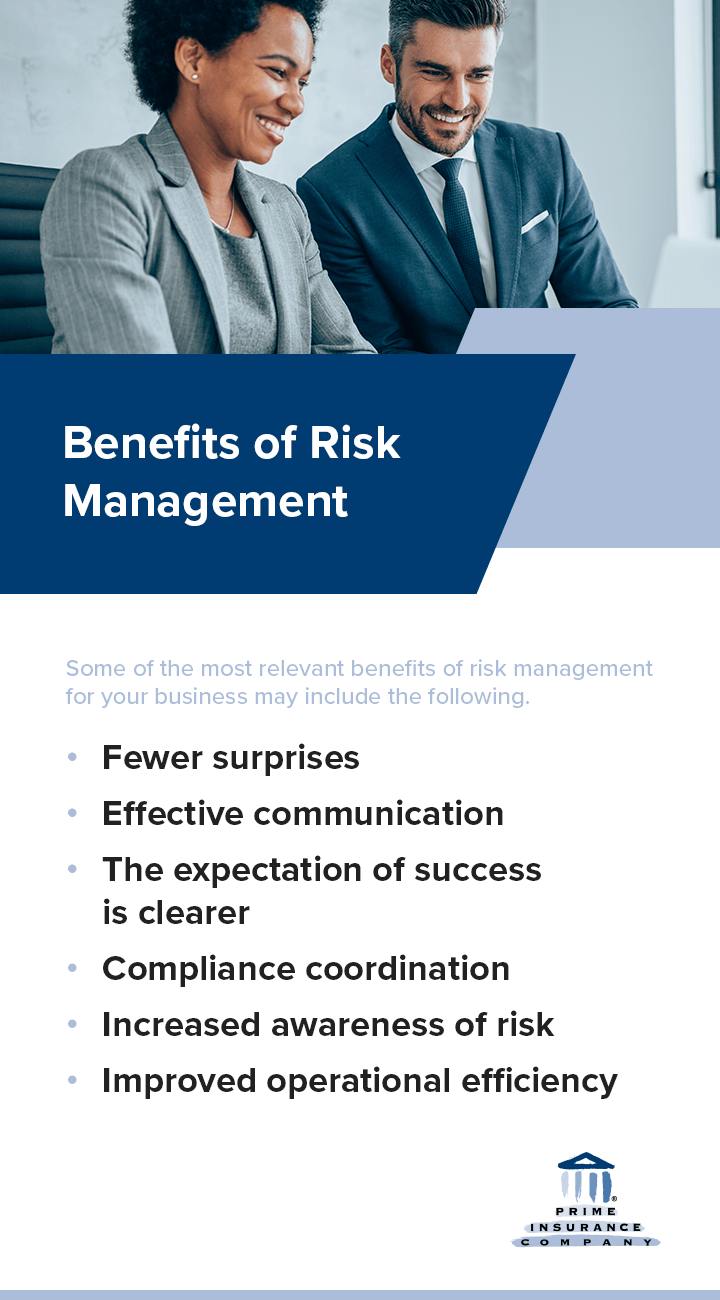Preparing a response to unexpected loss or damage can be essential for any business owner, including insurance producers. Being proactive can help you predict and detect potential obstacles and challenges that can cause financial or legal problems, also known as risks. Various risks can affect your insurance business in many ways.
Before insurance producers can protect businesses against extensive complications, there must be a plan for taking action against issues that arise. You can never be too cautious with your profits and resources, and creating a risk management strategy can provide peace of mind. What is risk analysis? Here, we’ll discuss risk management FAQs and solutions that assist insurance agents and brokers in accomplishing goals.
What Is Risk Management?
Risk management is the process of identifying, evaluating and assessing various ways to avoid liabilities and loss. Risk management can include many different elements, and some pitfalls may be more damaging than others. It’s a best practice for insurance producers to familiarize themselves with the kinds of risks they might encounter.
- Financial risk: This type of risk can involve unexpected loss, increased debt load, costs of claim and liabilities or tax and interest rate fluctuations.
- Operational risk: Operational risks can disrupt business flow. Examples include labor strikes, natural disasters and internal or external problems such as technical or process failures.
- Economic risk: Changing market trends cause the economy to fluctuate. This type of risk can interrupt business finances and cash flow or lead to a loss of revenue.
- Compliance risk: All businesses need to consider and regularly track compliance laws and regulations. Otherwise, there is a chance for fines and penalties.
- Strategic risk: Any damage or loss to reputation may present a strategic risk, which could prevent your business from reaching its goals or implementing plans.
- Knowledge risk: This type of risk may involve a lack of knowledge or skills about specific procedures, projects or technology, leading to loss or damage.
The Importance of Risk Management
Risk management is vital for improving the odds of success and reducing the chance of any threats that may hinder progress or growth. Risk management tactics can introduce and establish a backup system or proactive measures to reduce the overall cost of an unexpected event. Insurance producers must implement risk management practices to manage the severity of loss and predict all possible hazards or disruptions you may encounter.
As an insurance producer, you can take control of risk management by identifying and mitigating risks to feel more confident and secure in your plans. Risk management enables insurance producers to make more efficient, informed decisions with access to necessary knowledge that helps keep your business and your clients’ companies profitable.
Embracing risk management tools can also present opportunities, such as knowing when to take on new business ventures or allocate resources. Some risk-taking may be necessary for your company to reach its goals, so it’s critical to know how to adequately manage all possibilities and unexpected issues. Creating a deliberate, consistent approach to risk management may help you protect your and your customers’ valuable assets and vulnerabilities from threats or damage.
Understanding the different possible risks that may occur in business strategies or plans is fundamental to enabling resiliency and sustainability. Highlighting priorities and taking a proactive approach to risk management may also ensure a competitive advantage for your insurance business.
The Risk Management Process
The risk management process typically involves a combination of steps that produce an effective solution. While these are not always one-size-fits-all, they can apply to many business circumstances.
- Identification: Recognize vulnerabilities in your business.
- Analysis: Assess the likelihood and consequence of possible risks.
- Evaluation: Discuss the impact or magnitude of the risk.
- Response: Determine if the risk is tolerable or if it necessitates a response.
- Review: Monitor and track risks going forward to minimize possible future threats.
When learning how to understand risk management, success hinges on being proactive instead of reactive. Staying ahead of the game may make it easier for you, as an insurance producer, to avoid losses or control them when they occur. Adapting these steps to your business needs can help solidify a risk management plan you can implement whenever and wherever necessary. For some projects or goals, formulating a risk management plan may be essential for addressing urgent or unavoidable threats.
How to Identify Risk
Spotting current and potential weaknesses or obstacles in your business is the first step in the risk management process. These weaknesses could include anything that may bring harm, damage, loss or any other adverse effects to your project or company. Financial loss, decrease in market share, economic downturn, employee vulnerability or bankruptcy are also examples of potential risks that may affect your or your customers’ business.
Insurance producers can recognize specific risks by looking for potential sources or highlighting specific problems that can lead to risk. This process typically involves brainstorming and gathering information to look for various vulnerabilities.
Liabilities can also consist of any circumstances that may prevent you or your customer from conducting business. Anything that interferes with the ability to perform a job or service represents a risk. When you recognize and describe different risks, record and review them regularly to ensure there haven’t been new developments or additional problems.
The risk identification process should also involve prioritization, so you can focus your attention on the most pressing matters. Depending on the obstacles you encounter, mitigating them all at once may not be possible. Identifying your insurance business’ most urgent needs can help you and your team deal with them before they become unmanageable.
How to Assess Risk
Once you have identified all possible risks, the next step is to decide on practical solutions. Risk analysis may involve understanding the impact specific events pose or how they may influence your business. As an insurance producer, your response to an urgent problem could significantly impact you and your customers.
Risk assessment involves predicting the probability of the identified risks and understanding the amount of damage or loss that may follow in a worst-case scenario. Once you have prioritized a list of risks, it may be easier to understand the loss and probability related to them.
Risk assessment is challenging because it involves a degree of uncertainty. You and your team must decide which ones to focus on, sorting them on a probability scale based on the likelihood they will occur and their expected impact on your operations.
Ranking risks on a scale may create a clearer vision of how they might financially affect and influence your insurance goals. This approach could also help insurance producers determine other possible consequences, which can lead to appropriate solutions.
Responses to Risk
After identifying the risks and assessing the various ways to resolve them, it is time to put the new plan into action. Responding to current threats or ones that may arise in the future is critical in managing loss exposure. Risk response commonly consists of implementing one or more of the following strategies.
- Avoidance: Avoiding a particular risk might involve not going through with a plan if you determine it could bring severe legal or financial consequences. However, avoidance may cause your business to miss out on opportunities.
- Transfer: Transferring the weight or responsibility of risk may reduce financial impact or damage by providing a safety net, such as acquiring insurance coverage for liabilities and assets.
- Reduction: Reducing the probability or impact of a loss by implementing preventive or protective measures may be helpful to ensure any risks that occur remain tolerable.
- Acceptance: This method is a backup when other approaches are not financially ideal or possible. Some risk-taking may be inevitable or have a low enough impact that it’s best to accept it.
As an insurance producer, you can evaluate the best method for responding, treating or modifying a risk to your insurance business. In doing so, you may deem some risks are acceptable, requiring less attention, while others are more severe. Creating responses to risks should also include preventive strategies and plans to assess and treat future risks quickly and effectively. This process may help you make decisions for your or your clients’ business in the future so there are controls and remedies in place when faced with new challenges.
Benefits of Risk Management
In your insurance business, you can take advantage of many risk management benefits. Staying prepared for unexpected events can help you effectively jump into action when a liability presents itself. Some of the most relevant benefits of risk management for your business may include the following.
- Fewer surprises: Planning for potential problems can help your team spot risks early on, which allows you to intervene before they occur.
- Effective communication: Consistent discussions and conversations about risks, responses, problems and resolutions may help your team work together more efficiently.
- The expectation of success is clearer: Risk management may provide a framework to predict project challenges and success, which may help you or your client determine productivity and outcomes.
- Compliance coordination: Implementing risk management processes may help your client deal with compliance regulations and mandates more efficiently.
- Increased awareness of risk: Identifying vulnerabilities in a business or project can heighten your client’s awareness of other possible risks or concerns.
- Improved operational efficiency: Risk management may allow for more control and confidence for a client or their business, leading to more effective overall operation.
While these benefits may be the most common ones your customer may see after implementing risk management, there are so many other positive aspects. Risk management may allow your insurance business to facilitate growth, understand your competition, properly allocate budget and resources and reduce disruptions. The benefits you and your client receive from risk management may improve your businesses and condition your teams to watch for negative impacts that could lead to legal or financial trouble.
Challenges of Risk Management
While plenty of benefits make risk management worth applying, you may encounter a few challenges during the process. Most risk management limitations and failures are avoidable, and they often result from a false illusion of control or lack of transparency. Here are some other challenges that may arise.
- Expenses: The expenses for risk management software and services may seem tricky to justify if you are on a tight budget.
- Awareness requires action: Understanding more about compliance regulations and mandates may cause you or your client to devote more time, money and energy to align with them properly.
- Consensus: All employees or team members within your insurance business may not always agree on which treatment method or response is best, which could cause a delay in coming up with the right solution.
- Fluctuating conditions: Keeping overhead costs in check may become an obstacle with changing economic conditions, loss of reputation or other issues that prevent your business from expanding innovation.
- Uncertainty: Risk-taking often involves uncertainty and guesswork to make projections. It may be challenging to discuss this with your insurance team if you can’t give them exact numbers or evidence.
For insurance producers, implementing a risk management plan takes time and patience, as it may not be perfect the first time you try to approach it. Seeing the value in this process is the first step. Without understanding risk management’s importance, your insurance business could encounter additional challenges that lead to penalties and project failures. Learning how to identify the most significant and high-priority vulnerabilities will allow insurance producers to take the necessary steps to handle risk exposure.
How to Create a Risk Management Plan
Creating a risk management plan that adapts to your business needs can be crucial to providing the best solutions for your clients. It may be helpful to determine what insurance problems or concerns you frequently encounter or what financial and legal issues you may have addressed in the past. Use this information to assess what parts of the risk management plan you need to administer immediately.
Breaking down the structure, roles and responsibilities may help you locate areas where your insurance business may be susceptible to risk or failure. Emphasizing communication and consulting about these aspects with your insurance team is an excellent way to see your business in a broader context. Some other elements of this may include business goals and objectives, company culture, business regulations and policies and the market or political environment.
After establishing communication patterns and business context, you can move on to the risk identification and assessment process. Evaluating what type of risks are worth responding to and which are within your limits and tolerance is a crucial step to understanding which methods and techniques to use to deal with those risks. Know and discuss your insurance business’ risk acceptance or mitigation options to decide on the most effective ways to apply those processes.
Finally, once you have concluded which risk response is best, continue monitoring the plan to ensure it’s working correctly and change it as necessary.
Examples of Risk Management
While avoidance, transfer, reduction and acceptance are all examples of risk management solutions, there are many other ways to put it into practice. For instance, having a backup plan for particularly significant risks is another example of management skills. As an insurance producer, you must regularly analyze and deal with potential threats to your and your clients’ goals. Here are some additional ways you can exercise risk management.
- Safety risk management: There may be operational safety risks within your insurance business. Consistently monitoring maintenance processes can help uncover issues, such as human error, that may present problems.
- Security risk management: This liability can occur in your data and information processing aspects, such as cybersecurity. Any insurance business should be aware to protect sensitive or private information and data. For example, prevent theft by implementing procedures for monitoring communication and valuable assets. This type of risk may also relate to fraudulent practices.
- Credit risk management: Mismanaged credit risk can quickly lead to financial loss. For example, giving extensive credit to an unreliable customer could hinder your profits.
- Market risk management: This type of risk is typical among all industries. When developing or advertising a new product or service, it can be challenging to determine its future value. Many businesses may try to handle this by involving investors to provide a sense of security in the face of changing market conditions.
- Industry-specific risk management: Insurance brokers and agents who wish to create new services and packages in their industry may run into challenges without risk analysis. It’s crucial to understand what hazards your business may face and if the benefits of your decisions outweigh the costs.
A consistent risk management system can help your business efficiently deal with all these issues. Without a plan, many of these risks can affect your insurance business’ survival, growth or success. Staying prepared to meet any possible concerns may give you better control and insight over outcomes for your company.
Develop Your Risk Management Plan Today
Prime Insurance Company can help insurance producers discover new ways to employ a risk management plan to fulfill your needs and client requirements. We proudly maintain an “A” rating from AM Best, and we prioritize providing customized coverage and solutions for business owners when standard markets don’t meet their insurance needs. Prime takes a hands-on approach to find unique solutions for your customers or your insurance business when faced with challenging or misunderstood risks.
Partnering with Prime additionally enables insurance producers to expand their portfolios and discover new opportunities, such as profit sharing. We also provide more convenience with in-house underwriting and risk management teams that work directly with policyholders and conduct on-site risk management visits for your clients. Prime’s team of attorneys and adjusters can work to fight claims and lawsuits that affect your insurance business with risk management practices to help eliminate or reduce controllable losses.
For more information, download our free e-book, visit our website to get a quote or contact us at 800-257-5590 today.
___________________________________________________________________________________________

Rick J. Lindsey hails from Salt Lake City, Utah. He began working in the mailroom of his father’s Salt Lake City insurance firm, getting his introduction to the business that became his lifelong career. Lindsey quickly rose through the ranks while working in nearly every imaginable insurance industry job. As an entrepreneur, specialty lines underwriter, claims specialist, risk manager, and a licensed surplus lines broker, Rick Lindsey is highly skilled in all levels of leadership and execution. As he progressed on his career path, Rick discovered an urgent need for insurers willing to write policies for high-risk individuals and businesses. He was frequently frustrated that he could not provide the liability protection these entities desperately needed to safeguard their assets. He also formed the belief that insurance companies acted too quickly to settle frivolous claims. Lindsey decided to try a different approach. He started an insurance company and became the newly formed entity’s CEO. This opportunity has enabled Rick to fill a void in the market and provide a valuable service to businesses, individuals, and insurance agents who write high-risk business. Prime Insurance also specializes in helping individuals and businesses who live a lifestyle or participate in activities that make them difficult for traditional carriers to insure. If you’ve been denied, non-renewed, or canceled coverage, don’t give up quite yet. Chances are Prime Insurance can help.






